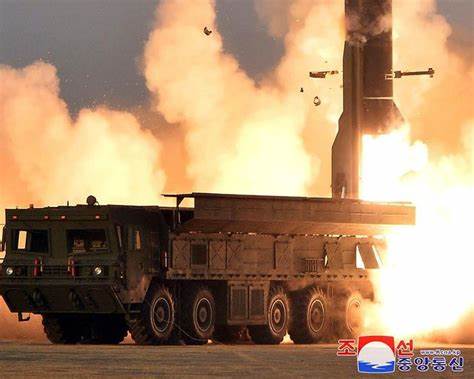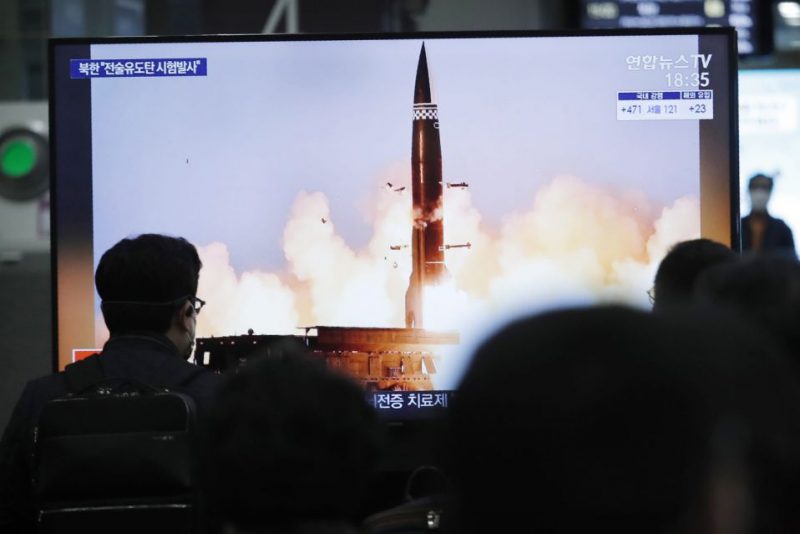Academy of Defence Science Test-fires New-type Tactical Guided Missiles

Pyongyang, March 26 (KCNA) — The Academy of Defence Science of the Democratic People’s Republic of Korea test-fired newly developed new-type tactical guided missiles on Thursday.
The test was guided by Ri Pyong Chol, member of the Presidium of the Political Bureau and secretary of the Central Committee of the Workers’ Party of Korea, officials of the Department of Munitions Industry of the Party Central Committee and leading officials in the sector of national defence scientific research.
The newly developed new-type tactical guided missile is a weapon system whose warhead weight has been improved to be 2.5 tonnes with the use of the core technology of tactical guided missile that was already developed.
The two testfired new-type tactical guided missiles accurately hit the target set in the waters 600 kilometers off the east coast of Korea.
Right after the test-firing, the Academy of Defence Science clarified that the test-firing was very successful just as it had been confidently predicted, adding that the reliability of the improved version of solid fuel engine was confirmed through several engine ground jet tests and their test-firing processes, and that the irregular orbit features of low-altitude gliding leap type flight mode already applied to other guided missile were also re-confirmed.
Ri Pyong Chol said that the test-firing is an important process in implementing the policy of national defence science set forth at the 8th Congress of the WPK and that the development of this weapon system is of great significance in bolstering up the military power of the country and deterring all sorts of military threats existing on the Korean Peninsula.
He immediately reported the successful result of the test-firing to the General Secretary of the WPK and conveyed the congratulations of the Party Central Committee to the sector of national defence scientific research.

***
Published by KCNA
Republished by The 21st Century
The views expressed in this article are solely those of the author and do not necessarily reflect the opinions of 21cir.
&&&
A related article from AP:
“EXPLAINER: North Korean missiles getting more agile, evasive”
AP writer Aamer Madhani contributed to the story from Washington.
SEOUL, South Korea (AP) — In resuming its ballistic testing activity after a yearlong pause, North Korea has demonstrated a potentially nuclear-capable weapon that shows how it continues to expand its military capabilities amid a stalemate in diplomacy with the United States.
The two short-range missiles the North fired into the sea this week were its first meaningful provocation since the inauguration of President Joe Biden, who on Thursday delivered a restrained response to the launches, saying “there will be responses if they choose to escalate.”
Since a provocative run in North Korean nuclear and missile tests in 2016 and 2017, much of the U.S. focus has been on North Korea’s intercontinental ballistic missiles that pose a direct threat to the American homeland.
But experts say North Korea’s growing arsenal of shorter-range solid-fuel weapons are more destabilizing for U.S. allies South Korea and Japan. And the latest launches underscored the North’s efforts to improve its capacities for delivering nuclear strikes and overwhelming missile defense systems.
__
THE MISSILE
North Korea’s state media said Friday the weapons it fired a day earlier from its eastern coast were a new type of “tactical guided projectile” that borrowed the core technology of an earlier system.
According to the Korean Central News Agency, the new solid-fuel missiles, which are designed to be fired from land vehicles, could be armed with warheads weighing as much as 2.5 tons.
During Thursday’s tests, the missiles demonstrated low-altitude, maneuverable flight and accurately hit a sea target 600 kilometers (372 miles) away.
Analysts say the North likely tested an upgraded version of a system modeled after Russia’s Iskander mobile ballistic missiles.
Their flatter trajectories compared to conventional ballistic weapons make them fly at an altitude where air is dense enough to allow for maneuverability. The unpredictability makes them harder to be intercepted by missile defense systems, experts say.
South Korea’s military took an unusually long time to release its assessment on the launches Thursday before it said hours later that the missiles traveled as far as 450 kilometers (279 miles).
Kim Dong-yub, a professor from Seoul’s University of North Korean Studies, said the discrepancy between the South Korean and North Korean assessments possibly shows how difficult it is for radar systems to accurately track these missiles during flight.
“Even if our military got things wrong, it doesn’t matter for now as they could easily adjust their assessment after analyzing satellite data,” said Kim, a former South Korean military official. “But how are you going to do that in times of war?”

THE WARHEAD
Whether missiles traveled 450 kilometers or 600 kilometers, that’s more than enough range to hit any corner of mainland South Korea. And experts say the North’s efforts to arm them with huge warheads indicate they are being designed for nuclear strikes.
The tests came after North Korean leader Kim Jong Un during a January ruling party congress vowed to bolster his nuclear deterrent in face of U.S.-led sanctions and pressure and issued a broad wish list of military hardware that included new tactical nuclear weapons.
If North Korea successfully develops an operational system, these missiles will provide an ability to launch tactical nuclear attacks on military bases and other strategic targets in South Korea, said Yang Wook, a military expert who teaches at South Korea’s Hannam University.
“We have long said it would be difficult for North Korea to put nuclear warheads on (short-range) missiles if it fails to make them small and light enough,” said Yang.
But North Korea would no longer have to do so if its missiles could reliably deliver a warhead of 2.5 tons, which Yang said would be more than three times heavier than most warheads on existing North Korean missiles.
Lee Choon Geun, a missile expert at South Korea’s Science and Technology Policy Institute, said the missiles would pose a huge threat for South Korea even if they are conventionally armed.
“A conventional warhead of 2.5 tons would be enough to bust deeply built bunkers,” he said. “That capacity would also allow for something more powerful than tactical nuclear weapons, possibly thermonuclear devices.”

MORE TESTING
North Korea has a history of testing new U.S. administrations with weapons demonstrations aimed at forcing the Americans back to the negotiating table.
Kim Jong Un so far has nothing to show for his ambitious summits with former President Donald Trump, which collapsed in 2019 over disagreements in exchanging the release of crippling U.S.-led sanctions against North Korea and the North’s disarmament steps.
While Thursday’s launches were less provocative compared to the nuclear and ICBM tests in 2017 that inspired war fears before the North shifted toward diplomacy with the Trump administration in 2018, most experts say the North is likely to dial up its testing activities.
The North conducted more than a dozen short-range launches amid stalled diplomacy in 2019 and 2020 as Trump dismissed the tests despite the threat they posed to South Korea and Japan.
The United States stations a total of 80,000 troops in the two Asian countries, the core of America’s military presence in the Asia-Pacific region.
“These missiles are no joke because it seems pretty clear they’re aiming to mount nuclear warheads,” and evade missile defense systems, said Duyeon Kim, a senior analyst at the Washington-based Center for a New American Security.
She said the nature of these missiles would require U.S. and South Korea to develop an effective response by returning to their normal scale and scope of joint military exercises, which have been downsized under the Trump administration to make room for diplomacy.
By AP writer Aamer Madhani contributed to the story from Washington.
